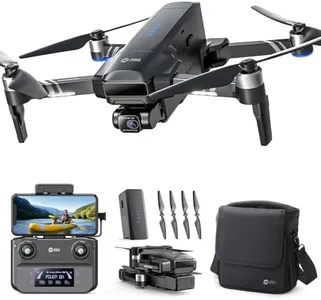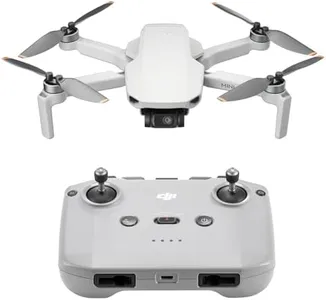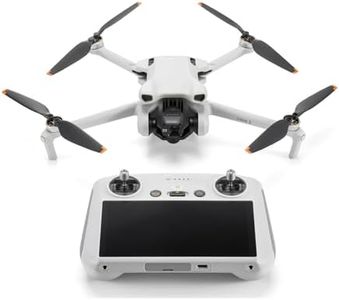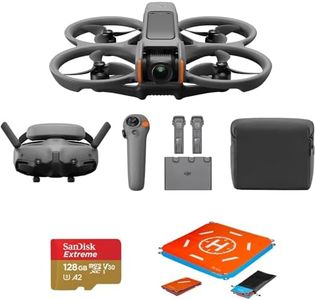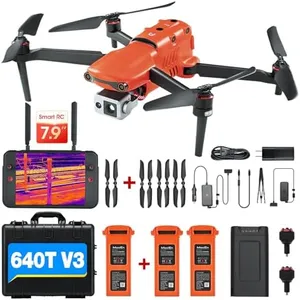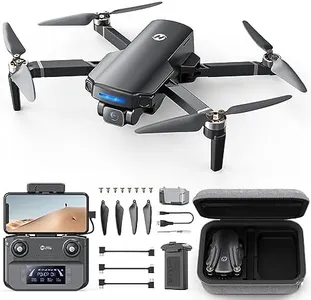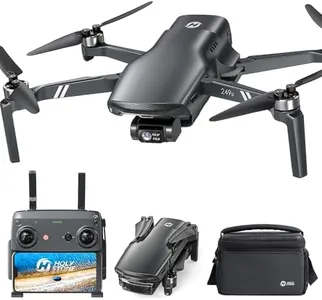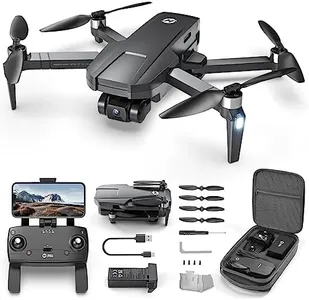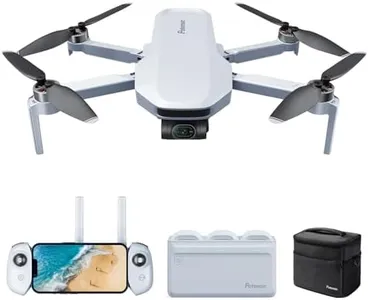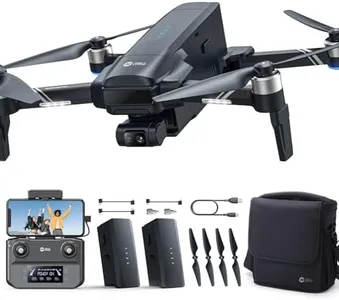10 Best Drones With Camera And Gps 2025 in the United States
Our technology thoroughly searches through the online shopping world, reviewing hundreds of sites. We then process and analyze this information, updating in real-time to bring you the latest top-rated products. This way, you always get the best and most current options available.

Our Top Picks
Winner
DJI Mini 4K, Drone with 4K UHD Camera for Adults, Under 249 g, 3-Axis Gimbal Stabilization, 10km Video Transmission, Auto Return, Wind Resistance, 1 Battery for 31-Min Max Flight Time, Intelligent Flight
Most important from
1647 reviews
The DJI Mini 4K drone is designed to be lightweight and portable, weighing in under 249 grams, which means it does not require FAA registration for recreational use. Its standout feature is the 4K Ultra HD camera paired with a 3-axis gimbal, delivering high-quality, stable footage suitable for various lighting conditions. The drone offers a maximum video transmission range of 10 km, which is impressive and allows for extensive exploration with clear HD video feedback.
With a flight time of up to 31 minutes on a single battery, it provides ample duration for most recreational flights, and additional battery options can extend this significantly. Stability and wind resistance are strong points, as it can handle winds up to 38 kph (Level 5), thanks to its brushless motors and design. The GPS accuracy is reliable, supporting features like auto return to home and stable hovering, which ensures the drone remains in control and safe.
It is beginner-friendly with one-tap takeoff and landing, as well as various intelligent flight modes like QuickShots for automated, professional-grade video capture. However, it lacks advanced obstacle avoidance technology, which might be a concern for new pilots. The removal of the DJI Fly app from Google Play could also be inconvenient for some users, as it requires downloading from DJI’s official website. Despite these drawbacks, the DJI Mini 4K is a great choice for beginners and those looking for an affordable and easy-to-use drone with excellent camera capabilities and solid flight performance.
Most important from
1647 reviews
DJI Mini 3 (DJI RC), Lightweight 3x Mechanical Gimbal Drones with Camera for Adults 4K, 38-min Flight Time, up to 32800ft (10km) Video Transmission, Vertical Shooting, GPS Auto Return Integrated
Most important from
4182 reviews
The DJI Mini 3 is a compact and user-friendly drone that excels in delivering high-quality 4K footage, making it an excellent choice for photography enthusiasts and casual users alike. With a lightweight design under 249 g, you won’t need FAA registration, allowing for easy accessibility. The drone offers impressive flight time, boasting up to 38 minutes and even longer with an optional battery, which is particularly beneficial for extended shooting sessions.
You’ll appreciate its advanced features like a 3-axis mechanical gimbal for stable video capture, as well as GPS for precise hovering and automatic return to home functionality. These features are designed with beginners in mind, making it easy to learn and operate. The obstacle avoidance feature is also a significant plus, adding a layer of safety during flights.
On the downside, while the 10 km video transmission range is impressive, it may be limited by environmental factors that could affect performance. Additionally, while the 4K imagery is stunning, some users may find the lack of advanced professional features restricting for serious filmmaking. The drone is also categorized as beginner to intermediate, which might not satisfy those looking for a more advanced flying experience. For those who value portability, the DJI Mini 3 is foldable, making it easy to transport. However, if you're considering using the extended battery, be mindful that it will increase the weight and may require registration. In conclusion, the DJI Mini 3 is ideal for casual users and hobbyists who prioritize high-quality aerial photography and ease of use, but it may not meet the needs of professional content creators seeking advanced capabilities.
Most important from
4182 reviews
DJI Avata 2 Fly More Combo (3 Batteries) FPV Drone with Camera 4K, One-Push Acrobatics, Propeller Guard, 155 FOV, Camera Drone, Goggles 3 & RC Motion 3 + SD Card & Landing pad
Most important from
48 reviews
The DJI Avata 2 Fly More Combo is a feature-packed FPV drone that excels in providing an immersive flying experience. Equipped with 4K video capture and a 155° field of view, it delivers remarkable camera quality, allowing users to capture stunning footage. The intuitive motion control system simplifies operation, making it accessible even for beginners.
The drone's ability to perform acrobatics without extensive training is a standout feature, enhancing the flying experience. Three included intelligent batteries significantly extend flight time, ensuring more time in the air between charges. Additionally, its built-in propeller guard enhances safety and durability, making it robust for varied flying conditions.
The portability aspect is well-covered with the lightweight design and included landing pad. At 6.2 pounds, the drone may be heavier compared to some competitors, which could affect portability for some users. Despite this, the DJI Avata 2 is well-suited for enthusiasts looking for high-quality video capture, easy control, and immersive flying experience.
Most important from
48 reviews
Buying Guide for the Best Drones With Camera And Gps
When choosing a drone with a camera and GPS, it's important to consider several key specifications to ensure you get the best fit for your needs. Drones can be used for various purposes such as photography, videography, surveying, or just for fun. Understanding the key specs will help you make an informed decision and get the most out of your drone experience.FAQ
Most Popular Categories Right Now
